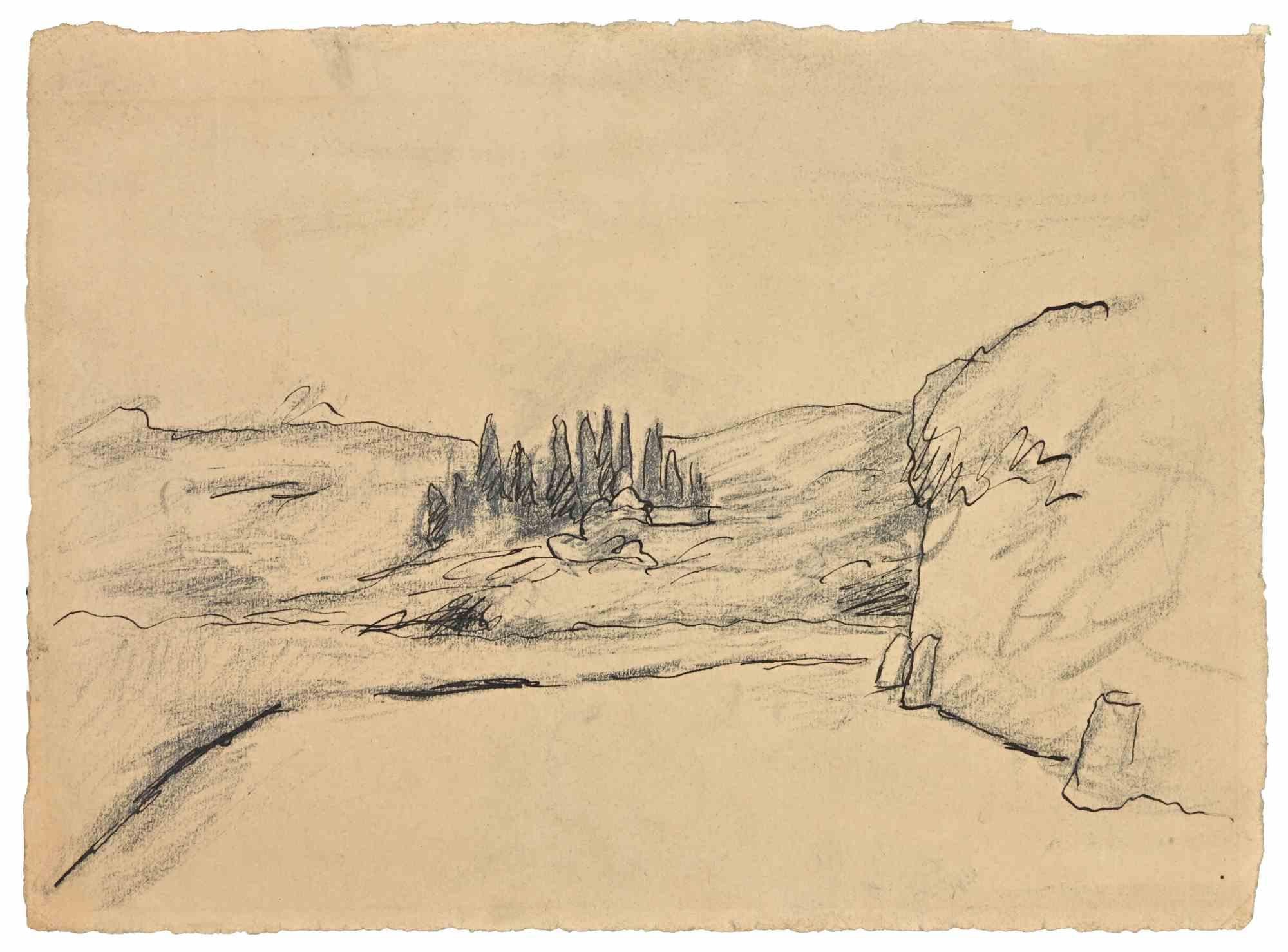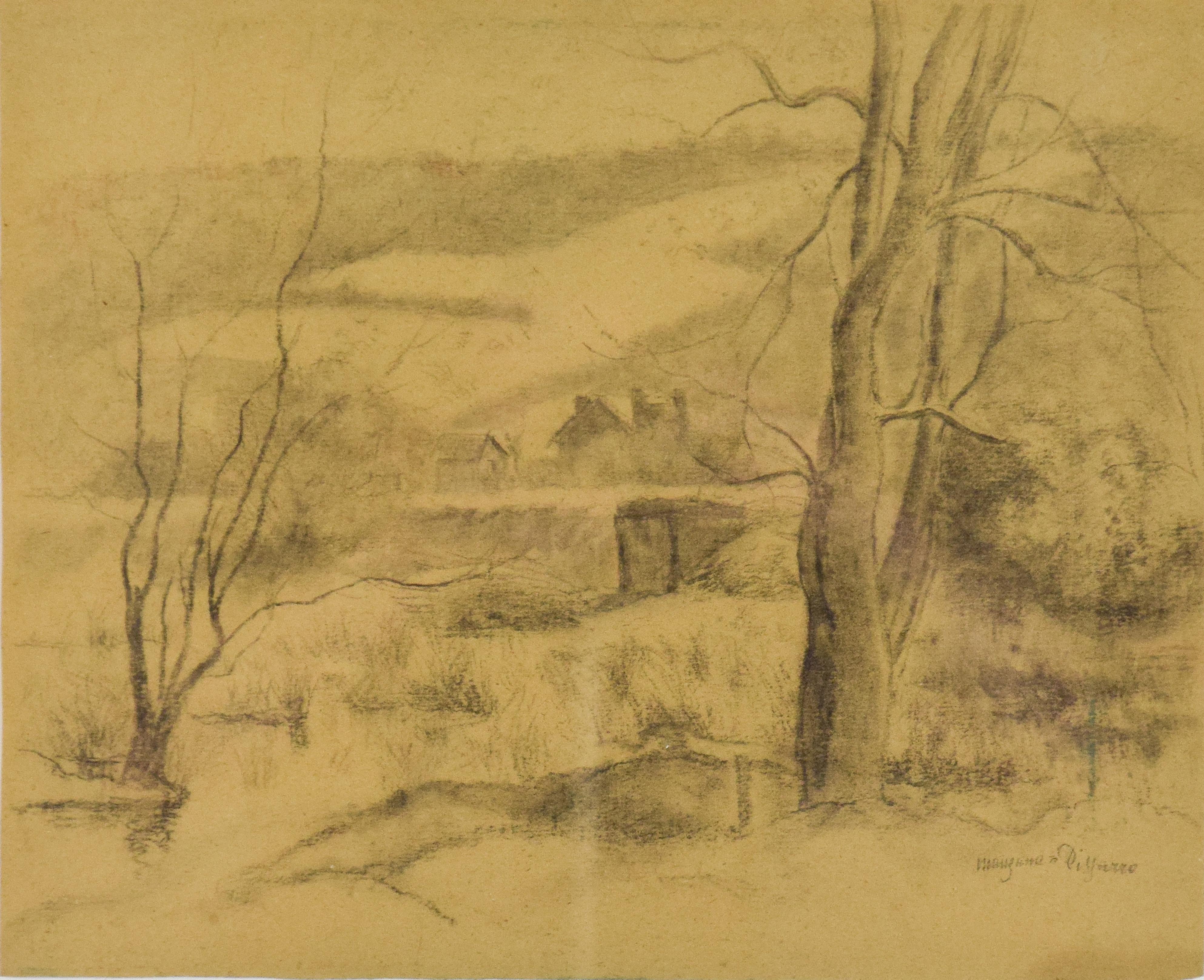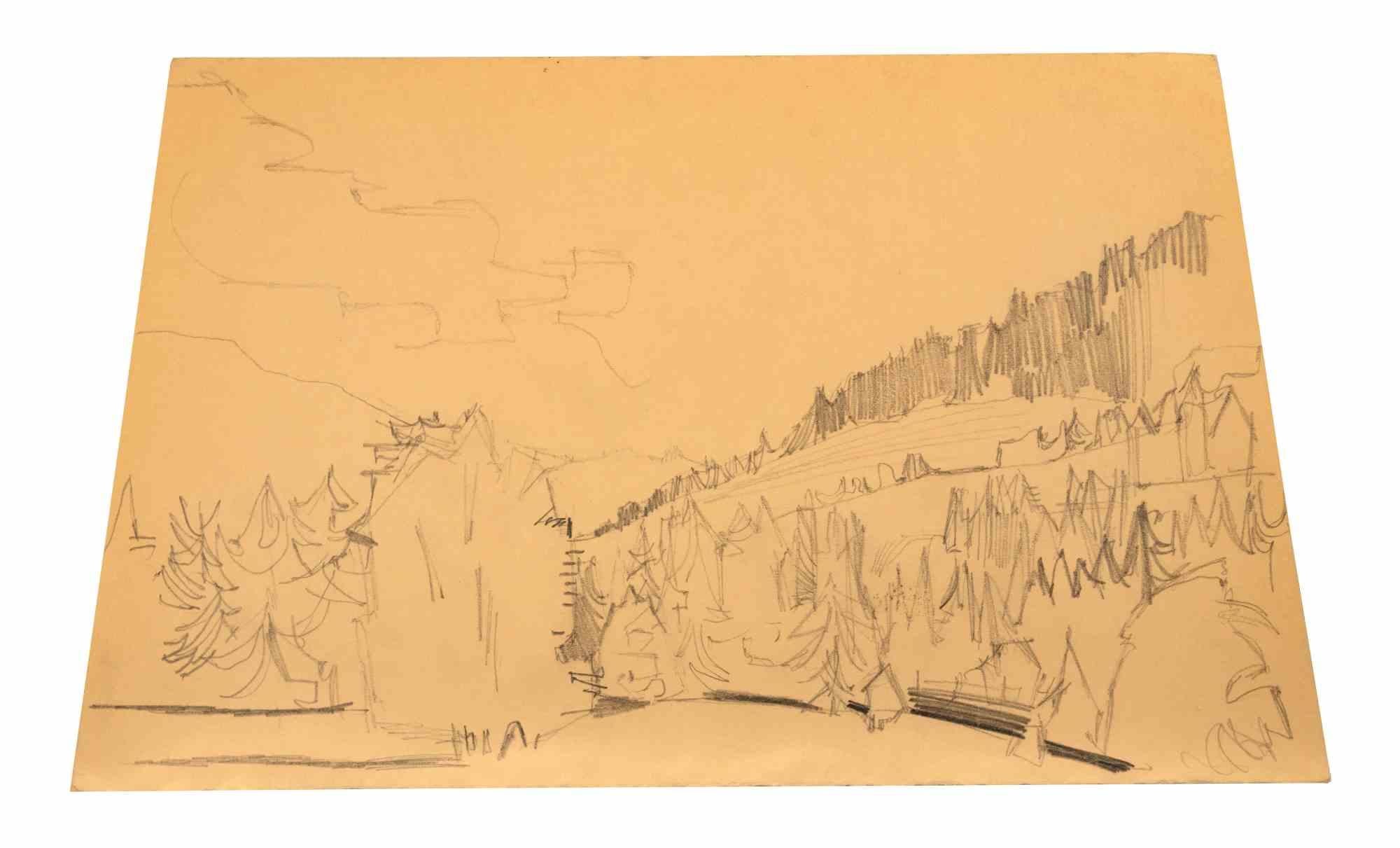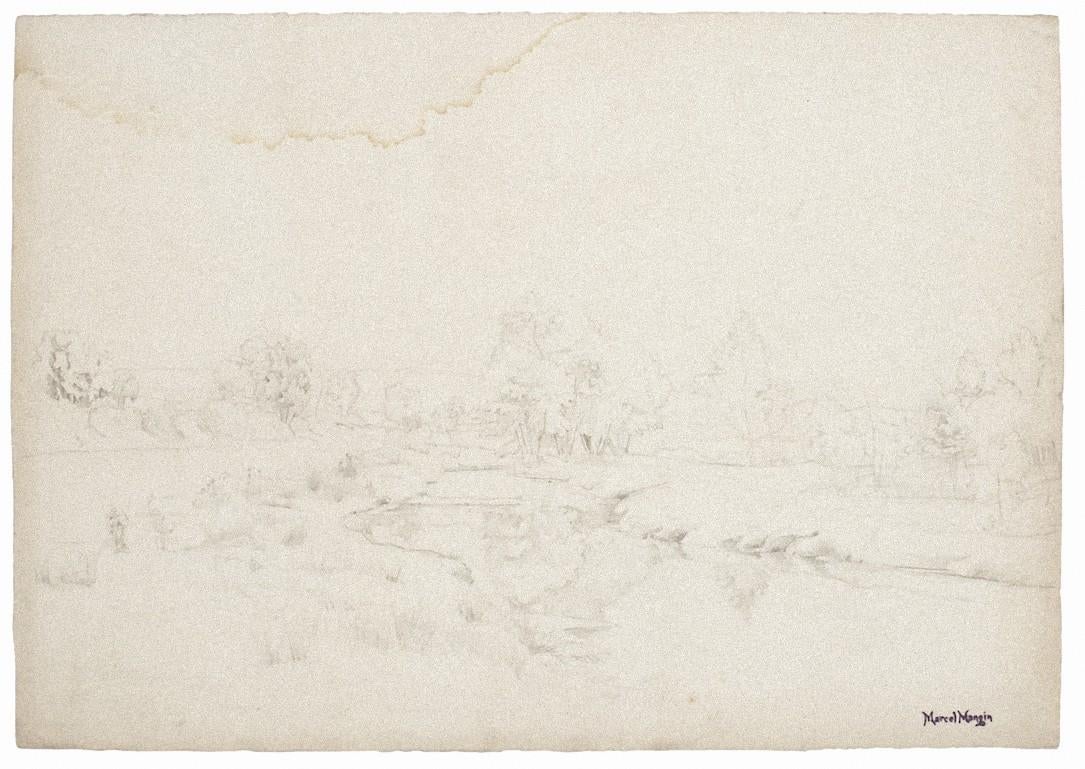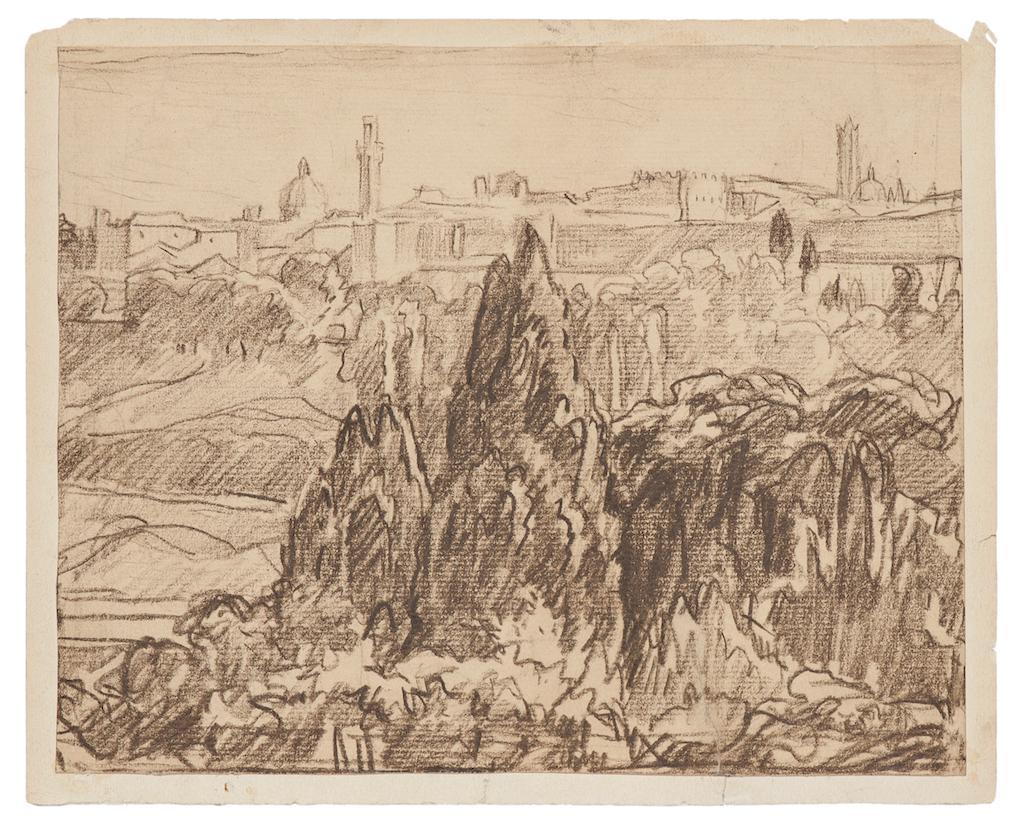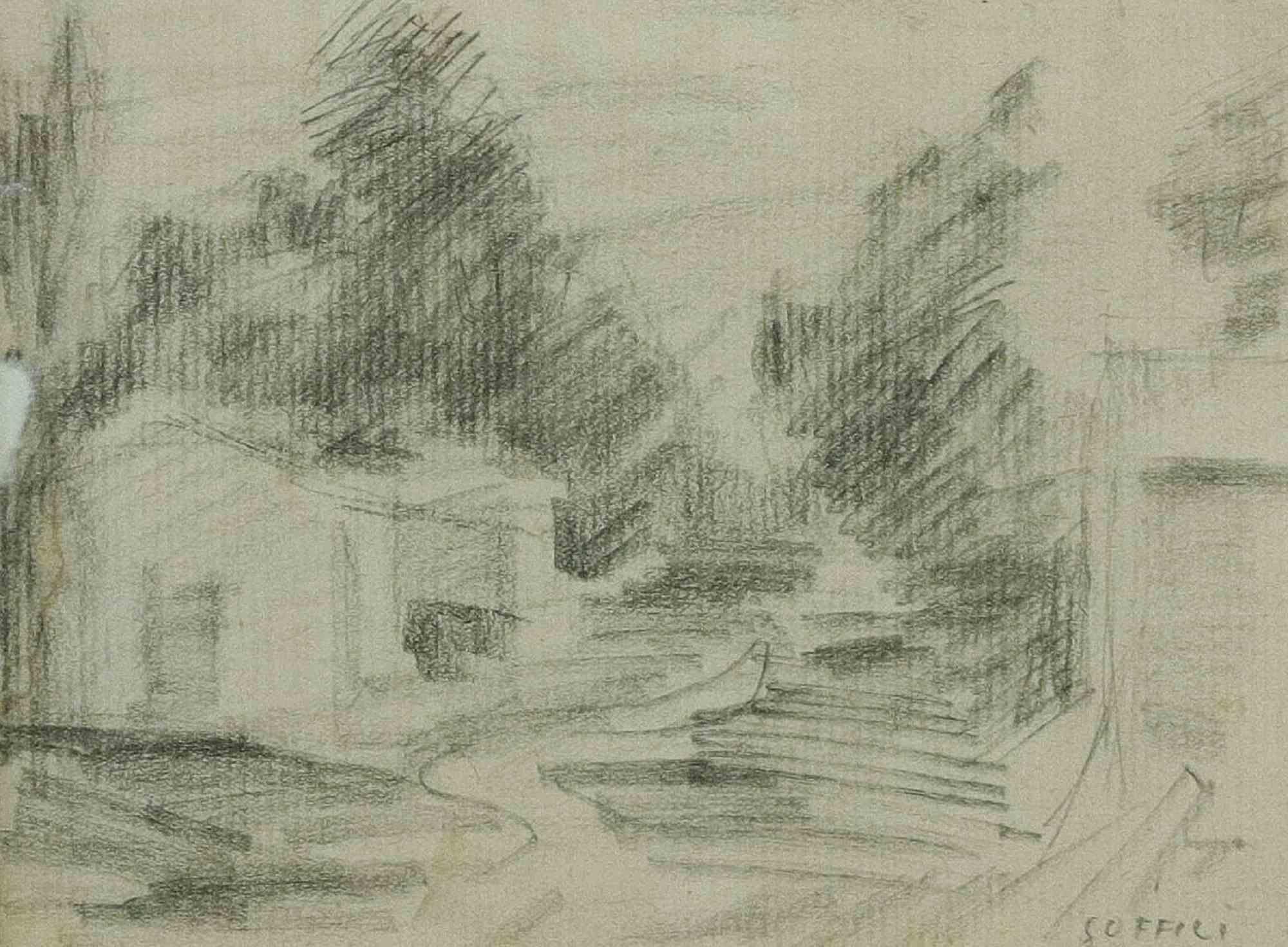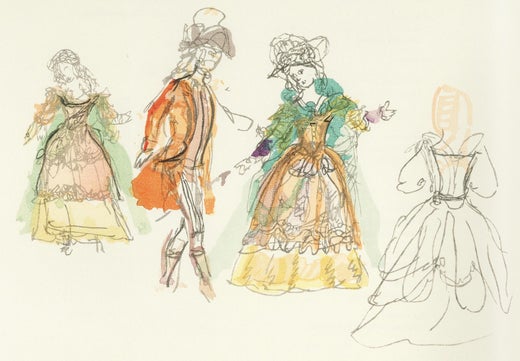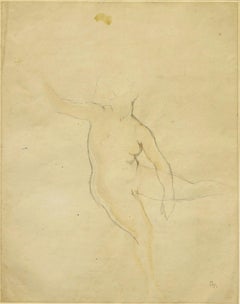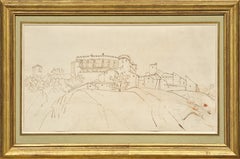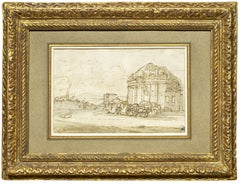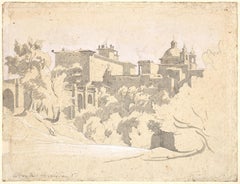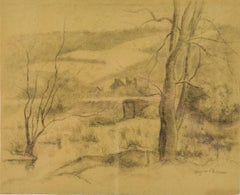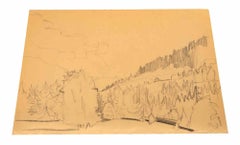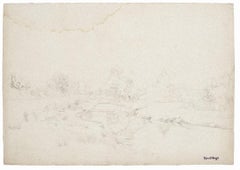Items Similar to Study for « Paysage de Fribourg » - 1943 a drawing by Balthus (1908 - 2001)
Want more images or videos?
Request additional images or videos from the seller
1 of 8
Balthus (Balthasar Klossowski de Rola) Study for « Paysage de Fribourg » - 1943 a drawing by Balthus (1908 - 2001)
$16,174.94
£12,041.19
€13,500
CA$22,155.62
A$24,641.89
CHF 12,867.23
MX$299,865.56
NOK 164,334.14
SEK 154,116.43
DKK 102,770.79
Shipping
Retrieving quote...The 1stDibs Promise:
Authenticity Guarantee,
Money-Back Guarantee,
24-Hour Cancellation
About the Item
Provenance: Frédérique Tison, Château de Chassy (Burgundy-Franche Comté - France)
Bibliography: J. Clair, V. Monnier Balthus, catalogue raisonné of the complete works, Gallimard, Paris 1999 - number D513 reproduced in black and white (page 231)
Related works :
• Another preparatory study (pencil on paper - 33x45.1 cm) is listed in the catalogue raisonné as D512
• A sketch in a sketchbook (catalogue raisonné reference CC1469/9)
• Paysage de Fribourg, an oil on canvas executed in 1944, dimensions 72 x 99 cm, referenced in the catalogue raisonné under number P146 (sold at Sotheby's on 4 December 1984 - number 71)
Balthus lived in Switzerland during the war and this preparatory study is a souvenir executed during the last days of his stay in Fribourg. Evoking the landscapes of the Italian primitives, he presents us with an immense, shadowless landscape, captured by the immobility of winter. The various preparatory studies allow us to better understand the artist's creative process.
1. Balthus, a unique artist in the art of the 20th century
Balthus occupies a special place in 20th century art, which is often marked by the legacy of Marcel Duchamp or turned towards abstraction. Balthus, on the contrary, presents figurative work, based on rigorous drawing and characterized by his ability to master form through meticulous construction. The work attracts and the artist disconcerts; there is somewhat of a "Balthus mystery", largely maintained and staged by the artist himself. During his lifetime, his work was the subject of numerous exhibitions organised in the world's greatest museums (at the Musée des Arts Décoratifs in Paris in 1966, at the Tate Gallery in London in 1968, at the Centre Pompidou in Paris and at the Metropolitan Museum of Art in New York in 1983-1984, and at the Palazzo Grassi in Venice in 2001, to name but a few).
Balthus was born on 29 February 1908 into a cosmopolitan family; his father was of Prussian and Polish origin and his mother, Elsa Dorothea Spiro, nicknamed Baladine, was of Ashkenazi and Russian descent. At the beginning of the war, his family took refuge in Switzerland, where he stayed with his mother while his parents separated. In 1919, his mother met the poet Rainer Maria Rilke (1875 - 1926) who became her lover; Balthus (the nickname of the painter from which he chose his artist's name) was brought up in the artistic milieu of his mother's friends.
Balthus moved to Paris with his mother in 1924. He enrolled at the Grande Chaumière academy and frequented Pierre Bonnard's studio. In 1926, he travelled to Italy where he discovered the frescoes of Piero della Francesca and Masaccio, which had a lasting influence on his art. Influenced by the surrealists, he held his first solo exhibition in 1934. Alongside his paintings, which were increasingly successful, he created several theatre, ballet and opera sets, an activity he continued after the war. In 1938, he held his first exhibition in New York.
He married Antoinette de Watteville (1912-1997) in 1937 and the couple settled during the war first in Champrovent in Savoie, then in Fribourg in Switzerland where two of their sons were born and finally in Cologny near Geneva from 1942 onwards. In 1945 the couple separated and Balthus returned to Paris.
In 1953, Balthus, then aged 45, decided to move to the Château de Chassy in the Morvan region. He was soon joined there by his niece by marriage (the daughter of his brother Pierre Klossowski's wife from her first marriage), Frédérique Tison, who became his muse and mistress. At Chassy, facing the landscapes of the Morvan, in the immense space of the house, Balthus worked and created a huge number of works. His painting evolved to become closer to the fresco, in the manner of the Italian Renaissance masters.
Frédérique Tison accompanied Balthus to Rome when he was appointed Director of the Villa Medici by André Malraux in 1961. When they finally broke up in 1966, Balthus gave her Chassy where she settled. In 1962, during a trip to Japan, Balthus met Setsuko Ideta. She became his wife in 1967. In 1977, at the end of their time in Rome, they settled in a large chalet in Rossinière (Switzerland) where the painter lived until his death on 18 February 2001.
2. Description of the artwork
This landscape allows us to discover vast horizons with meandering views of the Sarine, the river that crosses Fribourg. The site is easily identifiable on a map of Fribourg and was probably drawn from the terrace of the Cordeliers convent, overlooking the other bank. The geometrically shaped hills rise towards the horizon; the landscape is structured by the many paths that cross it. A human presence is represented by a tiny, enigmatic silhouette on the edge of the river. The introduction of this figure allows us to measure the distance that separates us from the other bank and the immensity of this panorama. Like the landscapes depicted in the backgrounds of the Italian primitives, no shadows are represented, which gives this winter landscape a hypnotic strangeness.
The rather vaporous nature of the drawing, in which the landscape appears to be shrouded in a winter mist, contrasts with the precision with which the group of buildings and the few trees surrounding them in the foreground on the left are described. This meticulous description, together with the rather Germanic character of the building, evokes the precision of Dürer's landscapes.
3. Related works and creative process
A sketch kept in a sketchbook and another preparatory drawing give us a better understanding of the artist's creative process leading to the final painting.
It seems likely to us that the study in the sketchbook was the first idea for the painting and that Balthus subsequently studied the right-hand side (the drawing we are presenting) and the left-hand side of the painting in two separate studies that partly overlap (the house at the foot of the hill in our drawing being the one we find at the extreme right of the other study).
While in the final painting Balthus accurately reproduces the group of buildings on the right of our drawing, the group on the left of the other study is vastly simplified, while the river in the foreground is given a much more prominent place.
We have chosen to frame this preparatory drawing in a 17th century Spanish frame with faded gilding which further enhances the timelessness of this winter landscape.
Main bibliographic reference :
J. Clair, V. Monnier Balthus, catalogue raisonné of the complete works, Gallimard, Paris 1999
- Creator:Balthus (Balthasar Klossowski de Rola) (1908 - 2001, French)
- Dimensions:Height: 14.75 in (37.47 cm)Width: 19.69 in (50.02 cm)
- Medium:
- Movement & Style:
- Period:
- Condition:Size : 14 3/4" x 19 11/16" (37.5 x 50 cm) Framed 27’’x 31 ¾” (68.7 x 80.7 cm).
- Gallery Location:PARIS, FR
- Reference Number:1stDibs: LU156829447272
Balthus (Balthasar Klossowski de Rola)
Balthus was born on 29 February 1908 into a cosmopolitan family; his father was of Prussian and Polish origin and his mother, Elsa Dorothea Spiro, nicknamed Baladine, was of Ashkenazi and Russian descent. At the beginning of the war, his family took refuge in Switzerland, where he stayed with his mother while his parents separated. In 1919, his mother met the poet Rainer Maria Rilke (1875 - 1926) who became her lover; Balthus (the nickname of the painter from which he chose his artist's name) was brought up in the artistic milieu of his mother's friends. Balthus moved to Paris with his mother in 1924. He enrolled at the Grande Chaumière academy and frequented Pierre Bonnard's studio. In 1926, he travelled to Italy where he discovered the frescoes of Piero della Francesca and Masaccio, which had a lasting influence on his art. Influenced by the surrealists, he held his first solo exhibition in 1934. Alongside his paintings, which were increasingly successful, he created several theatre, ballet and opera sets, an activity he continued after the war. In 1938, he held his first exhibition in New York.
He married Antoinette de Watteville (1912-1997) in 1937 and the couple settled during the war first in Champrovent in Savoie, then in Fribourg in Switzerland where two of their sons were born and finally in Cologny near Geneva from 1942 onwards. In 1945 the couple separated and Balthus returned to Paris. In 1953, Balthus, then aged 45, decided to move to the Château de Chassy in the Morvan region. He was soon joined there by his niece by marriage (the daughter of his brother Pierre Klossowski's wife from her first marriage), Frédérique Tison, who became his muse and mistress. At Chassy, facing the landscapes of the Morvan, in the immense space of the house, Balthus worked and created a huge number of works. His painting evolved to become closer to the fresco, in the manner of the Italian Renaissance masters. Frédérique Tison accompanied Balthus to Rome when he was appointed Director of the Villa Medici by André Malraux in 1961. When they finally broke up in 1966, Balthus gave her Chassy where she settled. In 1962, during a trip to Japan, Balthus met Setsuko Ideta. She became his wife in 1967. In 1977, at the end of their time in Rome, they settled in a large chalet in Rossinière (Switzerland) where the painter lived until his death on 18 February 2001.
About the Seller
5.0
Vetted Professional Seller
Every seller passes strict standards for authenticity and reliability
Established in 2020
1stDibs seller since 2021
10 sales on 1stDibs
Typical response time: 2 hours
- ShippingRetrieving quote...Shipping from: PARIS, France
- Return Policy
Authenticity Guarantee
In the unlikely event there’s an issue with an item’s authenticity, contact us within 1 year for a full refund. DetailsMoney-Back Guarantee
If your item is not as described, is damaged in transit, or does not arrive, contact us within 7 days for a full refund. Details24-Hour Cancellation
You have a 24-hour grace period in which to reconsider your purchase, with no questions asked.Vetted Professional Sellers
Our world-class sellers must adhere to strict standards for service and quality, maintaining the integrity of our listings.Price-Match Guarantee
If you find that a seller listed the same item for a lower price elsewhere, we’ll match it.Trusted Global Delivery
Our best-in-class carrier network provides specialized shipping options worldwide, including custom delivery.More From This Seller
View AllStudy for "Getting up" – 1955, a preparatory drawing by Balthus (1908 -2001)
By Balthus (Balthasar Klossowski de Rola)
Located in PARIS, FR
In 1955, as he was residing at the Château de Chassy in the Morvan for two years, Balthus created a large painting entitled "Getting up". Balthus was inspired for this painting by t...
Category
1950s Modern Nude Drawings and Watercolors
Materials
Watercolor, Pencil
View of a Mansion in the South of France, a drawing by Claude-Joseph Vernet
By Claude-Joseph Vernet
Located in PARIS, FR
We would like to thank Madame Beck-Saiello for confirming the autograph nature of this drawing after an in-person examination.
It was probably during an excursion in the countryside near Avignon that Claude-Joseph Vernet executed this drawing, enhanced with pen and brown ink, depicting a mansion on a hilltop overlooking a small village with geometric shapes.
1. Joseph Vernet, a painter influenced by Italy
Claude-Joseph Vernet was born in Avignon in 1714, the son of Antoine Vernet (1689-1753), an artisan painter of architectural decorations, coach panels, and the like. He moved to the studio of Philippe Sauvan (1697-1792), a leading history painter in Avignon, and then worked with Jacques Viali (active 1681-1745), a decorative, landscape, and marine painter in Aix-en-Provence. Vernet's first recorded paintings were decorative overdoors executed in 1731 in the Aix townhouse of the marquise de Simiane. In 1734, Joseph de Seytres, marquis de Caumont, a leading amateur in Avignon, sponsored Vernet to make a study trip to Italy to complete his artistic education and to draw antiquities for his patron.
As Avignon was a papal territory in Vernet's day, he also had a number of useful introductions among influential churchmen when he arrived in Rome. Vernet was soon at home in the French community there, and he was encouraged by Nicolas Vleughels (1668-1737), director of the Académie de France in Rome, even though the young painter had no official affiliation with the royal institution. He likely entered the studio of the French marine painter Adrien Manglard...
Category
1730s Old Masters Landscape Drawings and Watercolors
Materials
Ink, Laid Paper, Pen, Carbon Pencil
A landscape drawing by Claude Lorrain, with a preliminary sketch on the verso
By Claude Lorrain
Located in PARIS, FR
This study presents a typical Roman countryside landscape: an ancient mausoleum in front of which a cart is passing by followed by two peasants. If the technique (a pen drawing on graphite lines, completed with a wash of brown and grey inks) and the signature inevitably evoke the art of Lorrain, we find on the verso of this drawing additional evidences that lead us to consider this unpublished drawing as a work by the master.
The motif of the mausoleum has been taken up in pen on the verso in a technique that can be found in several other drawings by Lorrain. There is also a study of three characters, which can be considered as preparatory to Lorrain’s painting entitled The Port of Ostia with the Embarkation of Saint Paula, leading us to claim this attribution with a dating of around 1639.
1. Claude Lorrain or the perfection of classical landscape in Rome in the 17th century
Claude Gellée was born in 1600 in Chamagne in Lorraine. Orphaned at the age of twelve, he spent a year with his brother in Freiburg, where the latter was a woodcarver. Claude Gellée then probably arrived in Rome in 1613, where he joined the workshop of Agostino Tassi (1580 - 1644) in 1617. Between 1619 and 1620 he studied for two years in Naples in the workshop of Goffredi Wals (who was himself a former pupil of Tassi).
In 1625 he returned to Lorraine for two years where he worked alongside Claude Deruet. He then returned to Rome, a city he never left for the rest of his life (except for short trips to the surrounding countryside).
From 1627 to 1650 he lived in Via Margutta. From 1635 onwards he became a renowned painter and commissions started to pour in. Considered during his lifetime as the most accomplished of the classical landscape painters, his reputation never faded.
Between 1629 and 1635 Le Lorrain often went to the Roman countryside to draw with his friend Joachim von Sandrart (1606 - 1686). He became a member of the Academy of Saint Luke in 1633, while being closely acquainted with the Bentvueghels, this guild which brought together the young Nordic painters active in Rome. In 1643 he joined the Congregation of the Virtuosi. In 1650 he moved to Via Paolina where he lived until his death.
Little is known of his intimate life. He seems to have had a daughter, Agnes, from an ancillary love affair. In 1657/ 1658 she moved in with him. Stricken with gout in 1663, he died in 1682.
2. Description of the drawing; the technique of nature studies
Two peasants are walking behind a horse-drawn cart on a road that winds through ancient tombs. While a rectangular tomb with a columned facade can be seen in the distance, the cart passes an important ancient building. It has a circular shape and its partially ruined façade is decorated with columns. The start of a second floor can...
Category
1630s Old Masters Landscape Drawings and Watercolors
Materials
Ink, Pen, Graphite
View of Ariccia, a preparatory drawing by Achille Bénouville (1815 - 1891)
Located in PARIS, FR
This very modern drawing presents a view of Ariccia, a small town 25 kilometres south-east of Rome. The Palazzo Chigi (in which the film-maker Luchino Visconti would film a large part of The Leopard a century later) and the adjoining church are seen from the bottom of the ravine that surrounds the town. This drawing is a moving testimony to the attraction of the city for artists of the Romantic period, who established in Ariccia a vivid artists' colony.
1. Achille Bénouville...
Category
1850s Romantic Landscape Drawings and Watercolors
Materials
Ink, Gouache, Pencil
Study for the Spring (preparatory to the Four Seasons) by René-Marie Castaing
Located in PARIS, FR
René-Paris Castaing, winner of the Grand Prix de Rome in 1924, left a large body of work, both sacred and secular. Many churches in the Pyrénées-Atlantiques, in South-West France still bear witness to the diversity of his talent. In 1942, he began a major decoration project for the Château de Diusse, in the north-east of the county, including an allegory of the four seasons. The vigorous pastel we are presenting here is a study for Spring, depicted as Flore undressing. This commission was a veritable swan song for the artist, who died a year later at the age of 47.
1. René-Marie Castaing, the great inter-war painter in Pau
René-Marie Castaing was born in Pau on December 16th 1896. His father, Joseph Castaing, was also a painter: he was the official portraitist of Pau's high society, which was particularly cosmopolitan at the end of the century, when many rich foreigners spent the winter in Pau, taking advantage of the mild weather to enjoy an outdoor lifestyle punctuated by hunting, horse ridings and golf.
René-Marie Castaing was admitted to the Ecole Nationale Supérieure des Beaux-Arts in Paris in April 1920 and entered the studio of Paul-Albert Laurens (1870-1934). In 1924, he was awarded the First Grand Prix de Rome for Painting, which earned him a stay at the Villa Médicis for more than three years. He then returned to Pau in 1928, where he lived until his death.
Castaing's work is marked by the academic tradition, in which drawing plays as important a role as painting. Although his drawings are often sketches that help to set up large painted compositions, they stand as independent artworks in which the artist fully expresses the vivacity of his talent.
Castaing was a fervent Christian and religious painting played an essential part in his work, as shown by the decorations he created for the churches of Bizanos, Borce, Bidache and Salies-de-Béarn. The painter also created several secular decorations, such as that for the dining room of the Villa Saint-Basil's in Pau in 1935, and the Hunting at the Albret’s time commissioned in 1940 by the Prefecture of Pau. The décor created in 1942-1943 for the Château de Diusse, a mansion located north-east of Pau, was his last large-scale décor, as the painter died shortly after its completion on December 8th 1943.
2. Description of the drawing
Our pastel depicts an eminently secular theme: Spring is embodied by Flore, crouching on the ground with one knee touching the ground. She reveals her ample bosom by removing her shirt, her arms raised above her shoulders to undress.
Given Castaing's classical training at the Beaux-Arts and the influence of ancient statuary...
Category
1940s Art Deco Nude Drawings and Watercolors
Materials
Pastel
Landscape with Trees and a Fisherman walking, a drawing by Jan Van Goyen
By Jan Josefsz Van Goyen
Located in PARIS, FR
No Dutch draughtsman ever captured the atmosphere of the rural countryside of Holland with the same atmospheric and engaging simplicity that Van Goyen achieved in drawings such as this. Indeed, his landscapes were seminal in the development of the genre. The present sketch conveys a striking sense of movement within the natural landscape, conveyed by the deftly applied strokes of chalk, from which the artist’s hand can be sensed. The composition is characteristic of his work, with the low horizon affording significance to the broad sky and the soaring birds within. This feeling of windswept motion powerfully evokes the expansive Dutch farmland with which he was evidently preoccupied.
1. Jan van Goyen...
Category
1650s Old Masters Landscape Drawings and Watercolors
Materials
Chalk, Ink, Laid Paper
You May Also Like
Tuscan Landscape - Pencil Drawing i - 1930s
Located in Roma, IT
Tuscany Landscape is a beautiful pen and pencil drawing on cream-colored paper, realized in the 1930s by an Italian artist.
Good conditions with some foxing.
The artwork is realize...
Category
1930s Modern Figurative Drawings and Watercolors
Materials
Pen, Pencil
Paysage en Normandie by Georges Manzana Pissarro - Charcoal landscape
By Georges Henri Manzana Pissarro
Located in London, GB
Paysage en Normandie by Georges Manzana Pissarro (1871-1961)
Charcoal on paper
32 x 39 cm (12 ⅝ x 15 ⅜ inches)
Stamped lower right, Manzana Pissarro
Executed circa 1930
Artist biogr...
Category
1930s Post-Impressionist Landscape Drawings and Watercolors
Materials
Paper, Charcoal
Landscape - Drawing By Reynold Arnould - 1979
Located in Roma, IT
Landscape is a pencil drawing realized by Reynold Arnould (Le Havre 1919 - Parigi 1980).
Good condition on a yellowed paper.
No signature.
Reynold Arnould was born in Le Havre, ...
Category
1970s Modern Landscape Drawings and Watercolors
Materials
Paper, Pencil
Landscape - Original Pencil on Paper by Marcel Mangin - Mid-20th Century
By Marcel Mangin 1
Located in Roma, IT
Landscape is an original pencil on paper realized by Marcel Mangin.
Signed on the lower right.
Good conditions except for a trace of humidity on the up...
Category
Early 20th Century Modern Figurative Drawings and Watercolors
Materials
Pencil
Landscape - Charcoal Drawing on Paper by R. Santerne-Early 20th Century
Located in Roma, IT
Landscape is a beautiful original drawing on paper realized by Robert Santerne between the 1930s and 1940s.
Stamped on the rear "Atelier R.Santerne"
Aged conditions with repaired r...
Category
Early 20th Century Modern Figurative Drawings and Watercolors
Materials
Paper, Charcoal
Landscape - Drawing by Ardengo Soffici - 1932
By Ardengo Soffici
Located in Roma, IT
Landscape is an original modern artwork realized by Ardengo Soffici in 1932.
Pencil on laid paper.
Hand signed lower right.
Left margin restoration sign, generally in good conditi...
Category
1930s Modern Figurative Drawings and Watercolors
Materials
Pencil
More Ways To Browse
Large Landscape Drawing
Vintage Drawing Ideas
Pierre Bonnard Drawing
17th Century Italian Drawings
French Chateau Watercolor
Map Of Italy Framed
Descent From The Cross
Pierre Bonnard Sketch
Swiss Chalet
Chalet Painting
Vintage Paris Map Framed
Venice Souvenir
Andres Monnier
Burgundy Map
Swiss Chalet Painting
Klossowski Pierre
Still Life Of Italy
Bright Abstract Painting
